JPMorgan Chase on Thursday announced that it has created and successfully tested a digital coin. Each JPM Coin represents US$1 in funds held in designated accounts at JPMorgan Chase N.A.
The token was created using Quorum, a variant of Ethereum developed by JPMorgan Chase, to enable instantaneous payment transfers between its clients’ institutional accounts.
The JPM Coin and its underlying technology capabilities are currency-agnostic. Over time, the token will be extended to other major currencies and to other platforms. JPMorgan Chase says it will operate on all standard blockchain networks.
JPM Coin is currently a prototype, and JPMorgan Chase has not yet sought support from any regulators. It will do so as it moves toward production.
“The fact that JPMorgan Chase is issuing a token is overall very positive for development of corporate currencies and security tokens,” PCG Advisory Group CEO Jeff Ramson told the E-Commerce Times, “mainly because of the validation of the space that JPM brings.”
Not a Cryptocurrency or Stablecoin
JPM Coin differs from cryptocurrencies such as Bitcoin and Ethereum in that the latter are not collateralized, and their value is intrinsic to the currency.
Although JPMorgan Chase has said that its token also differs from fiat-backed Stablecoins, some observers consider it to be one, based on matching characteristics.
“The advantage here is the JPMorgan Chase backing, rather than a theoretical value,” said Rebecca Wettemann, vice president of research at Nucleus Research.
Although JPMorgan Chase will use the blockchain to settle transactions, that has no bearing on its acceptance of cryptocurrencies, PCG’s Ramson said. “Blockchain is a very important development, while cryptocurrencies — with no asset backing them — will diminish in significance.”
How JPM Coins Work
JPM Coins are transferred between parties in a transaction and instantaneously redeemed for the equivalent amount in U.S. dollars, reducing settlement times. JPMorgan Chase believes JPM Coin can reduce clients’ counterparts and settlement risk, decreasing capital requirements.
“The ability to accelerate settlements is important, given the volume of transactions and currency value fluctuations,” Wettemann told the E-Commerce Times.
JPMorgan Chase has concluded successful tests of the process between a client account and a J.P. Morgan account.
Pros and Cons of the JPM Coin Approach
“For certain types of interbank settlement, distributed (or synchronous) ledger technology (DLT/SLT) can create great efficiencies,” noted Steve Wilson, principal analyst at Constellation Research.
“When trading parties are at arm’s length, you normally need brokers and expensive reconciliation layers,” he told the E-Commerce Times. Using SLT lets certain types of multilateral settlements be agreed to in real time. “Everyone knows that everyone sees the same data, without any reconciliation.”
However, SLT “can be exorbitantly expensive and slow in transactions where there are natural intermediaries,” Wilson pointed out.
The JPM Coin might “add great respectability” to the acceptance of blockchain technology for mainstream use, he said.
Still, arm’s length interbank settlement “is a special case — certainly important, but not universally applicable,” Wilson said, “so let’s not get carried away. Blockchain is not the next Internet. Nor is it generally any sort of network of value transfer.”
Blockchain has been touted as the answer to the difficulties that arise when financial institutions work with SWIFT, the global network that lets them send and receive financial transactions information.
All About the Money
SWIFT faces competition from the Interbank Information Network, which JPMorgan Chase launched in October 2017. By the end of the year, more than 100 banks had signed up. They will be the first users of JPM Coin.
Another competitor is Ripple, an enterprise blockchain solution for global payments, which has signed up more than 100 banks worldwide.
SWIFT has been taking on the competition:
- In March it completed a DLT proof-of-concept for Nostro reconciliation with 34 participating banks;
- In November, SWIFT India launched a blockchain banking pilot with Monetago; and
- In December, SWIFT launched a pilot pre-validation system that uses an API to check data from other banks, in an effort to compete with fintech companies and blockchain startups.
However, “SWIFT is going to have to be very careful about its value proposition and its place in these new disintermediated settlement systems,” Constellation’s Wilson warned.
“The new ledgers need to not overreach,” he cautioned. “Even the best blockchain applications tend to overlook that tokenization is a form of admin, which the blockchain initially was dedicated to getting rid of.”
The Government Gets Involved
The United States government’s General Services Administration (GSA) has launched the U.S. Federal blockchain program.
In July 2017 it hosted a blockchain forum attended by multiple federal agencies, where advances in blockchain technology and use cases were discussed, and an agenda was set for working together to evaluate and implement blockchain in fulfilling the agencies’ diverse missions.
Last year, the U.S. Department of Homeland Security (DHS) began offering grants of up to $800K to fund anticounterfeiting solutions from blockchain startups.
It’s not clear how well blockchain will work in government.
“Because of the reality of public admin,” Constellation’s Wilson pointed out, “blockchain is much harder to generalize into governments.”

























































Social Media
See all Social Media